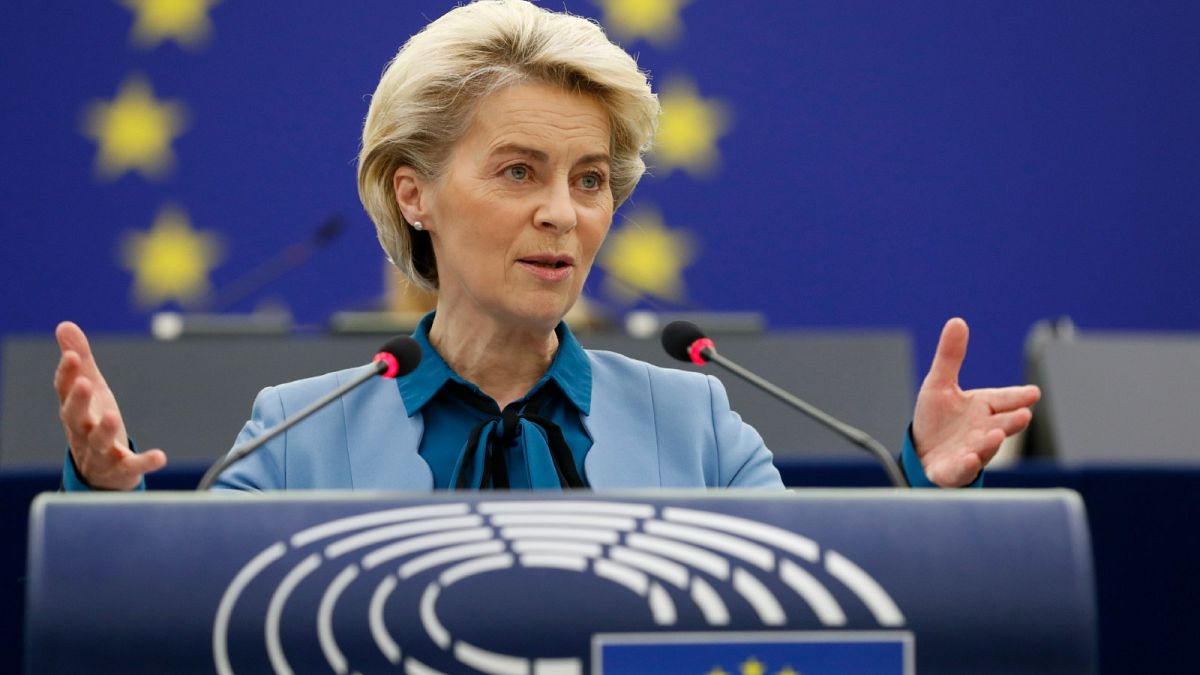Russia supplies about 40% of the EU's gas.
European Commission chief Ursula von der Leyen said on Wednesday that gas supplies to the bloc are on the "safe side" for the remainder of the winter even if Russia further squeezes out deliveries.
Speaking to MEPs in Strasbourg at the start of a debate on EU relations with Russia, von der Leyen said the bloc is "ready in case the Russian leadership decides to weaponise the energy issue".
"During the last weeks, we have looked into all possible disruption scenarios in case Russia decides to partially or completely disrupt gas supplies to the EU. And I can say that our models show that we are now rather on the safe side in this winter," she said.
Russia has amassed up to 150,000 troops along its shared border with Ukraine and in Belarus, according to Washington. This has stoked fears that it is getting ready to invade its neighbour.
Moscow denies the accusation but has issued a list of demands to NATO including a guarantee that Ukraine and Georgia will never be allowed to join the security alliance and that allied troops be withdrawn from some eastern European countries.
NATO has rejected these demands and high-level diplomatic talks have been ongoing for weeks.
In the meantime, NATO countries — most EU member states, Canada, the UK, and the US — have drawn up a list of economic sanctions they describe as "severe" that they will impose on Russia should it move ahead with a military incursion into Ukraine.
The EU has already stressed that these sanctions would have "massive" consequences for the Russian economy but also on its own economy and that Moscow could also retaliate by squeezing its gas supplies to the bloc.
The EU's dependence on Russian gas
Over a fifth of power generation in the EU comes from liquified natural gas (LNG) but about 90% of the bloc's gas supplies come from abroad. Russia, alone, supplies about 40% of the EU's gas.
Most of the Russian gas delivered to EU countries transit through the Nord Stream pipeline that goes through Ukraine. But Gazprom, Russia's majority state-owned energy company, has reduced deliveries to Europe in recent months in what some commentators have described as an attempt to bully the bloc into approving the Nord Stream 2 pipeline.
The pipeline, completed in the summer of 2021, bypasses Ukraine altogether to deliver gas from Russia to Germany through the Baltic Sea. Kyiv and Washington have decried it as a possible tool for Russia to pressure Ukraine which would lose out on revenues and security guarantees if gas headed for Europe no longer transits through its territory.
Lower deliveries coupled with higher demand globally as economies wake up following a COVID-induced coma has led to a price surge. Energy prices across the eurozone were in January four times higher than they had been at the same period in 2021.
EU member states have responded to these challenges by heavily tapping into their gas reserves. According to Gas Infrastructure Europe (GIE), an association representing the interests of European gas infrastructure operators, EU natural gas storage is only 33% full. Germany warned last week that its natural gas reserves have fallen to "worrying" levels at around 35-36%.
US gas deliveries rise sharply
Von der Leyen told lawmakers that the Commission is "currently in talks with a number of countries that are ready to step up their exports of liquefied natural gas to the EU."
"This resulted in January in record deliveries of LNG gas – more than 120 vessels and 10 bcm of LNG. On top, since the annexation of Crimea, we have increased the number of LNG terminals," she added.
The US supplied 23% of the EU's LNG needs in 2021. Last month, the share rose to 46% with Europe the top destination for American LNG.
Among the other countries that could step up in case the EU needs it are Qatar, one of the world's largest producers of LNG, and Azerbaijan.
Still, the Commission chief noted that "one of the lessons we can already draw from this crisis is that we must diversify our energy sources, to get rid of the dependency of Russian gas, and heavily invest in renewable energy sources."
"They are clean and good for the planet, and they are home-grown and good for our independence," she concluded.


